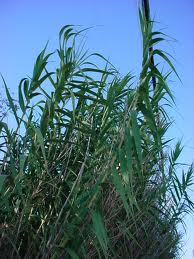

The nodes vary in length from 12 to 30 cm. The stem's bark (bassoonists like to refer to them as the "shell") contains silica and is very hard. The smooth and shiny surface turns a light golden yellow as the stem matures.
Giant reed grows rapidly. Growth rates up to 0.7 meters/week over a period of several months under favorable conditions is not unusual. Young culms develop the full diameter of mature canes; further growth involves thickening of the walls. The new growth is soft, very high in moisture and has little wind resistance.
Arundo donax is a native to the countries surrounding the Mediterranean Sea. From this area it has become widely dispersed, mostly through intentional introduction by man, into all of the subtropical and warm temperate areas of the world. Arundo donax is well established in many of these areas. Arundo donax grows abundantly in India, up to 2400 meters above sea level in the Himalayas, and it has spread to the east to Birma and China.



Arundo donax tolerates excessive saltiness and survives long periods of drought or extreme rainfall. The environment where the plant thrives the best is alongside lakes, ditches and rivers. Plants grow best in well-drained soils where abundant moisture is available. Arundo's ability to tolerate or even grow well under conditions of extreme drought is due to the development of coarse, drought- resistant rhizomes and deeply penetrating roots that can reach moisture at depth. Arundo donax can incur a lot of damage due to a lack of water during the first growing season, when its roots have not yet developed, but plants that are 2 to 3 years old handle long periods of drought without any major problems.
Arundo donax is a subtropical plant. I. A. donax can survive very low temperatures when dormant but is subject to serious damage by frosts after the start of spring growth.
The plant does not thrive well in real tropical environments.
The plant does not thrive well in real tropical environments.